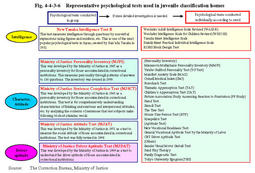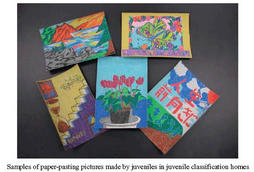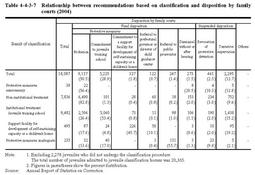| Previous Next Index Image Index Year Selection | |
|
|
3 Classification activities Fig.4-4-3-5 illustrates the regular flow of Institutional Classification.
Fig.4-4-3-5Flow of institutional classification in juvenile classification homes (1) Interview for classification Interviews are usually conducted one-on-one,between an officer in charge of classification and a juvenile,in a bright and tranquil atmosphere,paying full attention to the juvenile's anxiety and wariness.This aims to find out what the juveniles feel and how they respond to their surrounding environment,such as their families,friends,schools,and workplaces.
(2) Psychological tests Group psychological tests are conducted on juveniles within a few days after they enter a juvenile classification home,aiming to comprehensively understand their intelligence and attributes.If more detailed investigation is needed for juveniles'attributes,psychological tests are conducted separately on individual juveniles for more accurate classification.
Fig.4-4-3-6 illustrates representative psychological tests used in juvenile classification homes and the kinds of individual psychological tests actually used in2004. Fig.4-4-3-6 Representative psychological tests used in juvenile classification homes (3) Behavior observation In juvenile classification homes,juveniles'behavior is closely observed when they work on tasks,such as essays,paper-pasting pictures,painting,diary,group discussion,and description of impressions,etc.in order to understand their characteristics and problems in acts,clarifying their distinctive lifestyles and interpersonal relationships concretely and objectively.
Samples of paper-pasting pictures made by juveniles in juvenile classification homes (4) Medical diagnosis Health checkups are conducted when juveniles enter juvenile classification homes.If a juvenile is found to be suffering from injury or illness,medical care by a doctor is provided.For juveniles suspected to have a mental disorder,psychiatric examination and diagnosis by a psychiatrist is conducted.In2004,641juveniles(3.1%)were found to have a mental disorder(Source:Annual Report of Statistics on Correction).
(5) Classification Classification is determined as to whether to put a juvenile under non-institutional treatment(probation,etc.)or institutional treatment(at juvenile training schools,etc.),based on the results of the above-mentioned(1)to(4)and information from outside.The result of classification is recorded in a classification report and is sent to a family court as data for a hearing.If an adjudication of protective measures is made,the result is sent to a juvenile training school or a probation office for reference for the treatment.
Table4-4-3-7 shows the relationship between the recommendation based on classification and dispositions by family courts in2004. Among the juveniles for whom non-institutional treatment was recommended,82.8%were subjected to probation,while9.6%were placed under tentative supervision by family court probation officers with suspended disposition.As for those juveniles for whom commitment to juvenile training schools was recommended,53.4%were actually sent to training schools,but26.4%were placed on probation and15.2%under tentative supervision.For those who were considered to be inappropriate for protective measures and referral to a public prosecutor was recommended,55.7%were referred to a public prosecutor. Table4-4-3-7 Relationship between recommendations based on classification and disposition by family courts(2004) |



